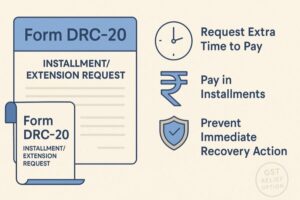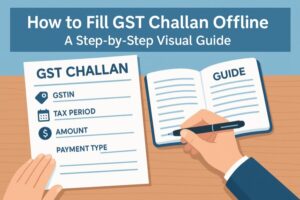A step-by-step guide on how to reconcile GSTR 1?
- 12 Aug 25
- 12 mins
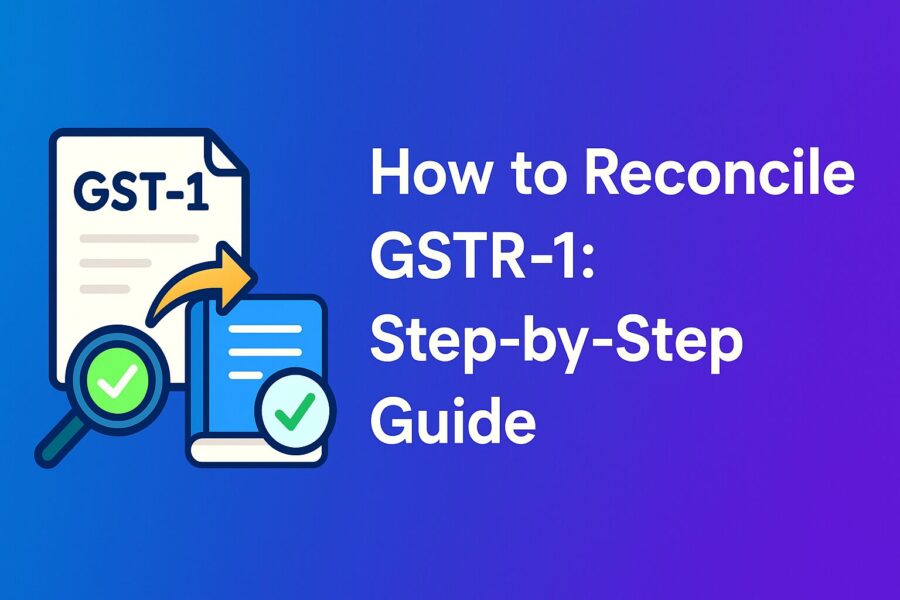
A step-by-step guide on how to reconcile GSTR 1?
- What Do You Mean by Outward Supplies?
- GST Reconciliation and Its Position in Pre-GST Regime and Post-GST Regime
- Various Types of GST Reconciliation
- GST Reconciliation: GSTR-1 vs Sales Register
- Important Reconciliations for a Proper GSTR-1 e-Filing
- How to Reconcile GSTR-1?
- What If Any Sales Invoice Gets Missed in GSTR-1?
- Conclusion
Key Takeaways
- GST reconciliation ensures that GSTR-1 return filing matches your sales register to avoid discrepancies and penalties.
- Regular GSTR-1 vs sales register reconciliation helps identify missing invoices and secure accurate Input Tax Credit (ITC) claims.
- Comparing GSTR-3B vs GSTR-2B reconciliation ensures correct ITC reporting and prevents GST compliance issues.
- Detecting errors early through GST return reconciliation avoids overpayment, underpayment, and potential GST registration risks.
- Using tools for automated GSTR-1 reconciliation reduces clerical errors and speeds up GST compliance for businesses.
Reconciliation of GST returns is the in-depth comparison of the data filed by a taxpayer with the data available in the GST government’s portal. This process helps identify discrepancies between the two sets of data, allowing you to correct any omissions or unintentional errors from previous filings. The goal is to ensure that both sets of data match accurately.
GST reconciliation is important to ensure correct tax payments and exclude any overpayment or underpayment of taxes. It is important for any taxpayer to adopt GST reconciliation, as not complying with this can lead to serious repercussions. It also allows you as a taxpayer to stay legally compliant with your obligations and maintain business compliance.
In this blog, we are going to learn how to reconcile GSTR-1 return filings with the sales register as developed by the GST-registered individuals themselves. However, let’s first understand GSTR-1 and the sales register in GST, individually before we dive into further details.
What Do You Mean by Outward Supplies?

The GSTR-1 is a return file that a taxpayer has to file on a regular basis, where they provide the details of any outward supply of goods or services that they make. A taxpayer can choose to file these outward supplies through a GSTR-1 return filing on a monthly or quarterly basis.
A GSTR-1 filing comprises details of various types of supplies. Here are some of them.
- Taxable outward supplies to a registered person, excluding zero-rated supplies and deemed exports
- Taxable outward supplies to an unregistered individual
- Outward supplies relating to NIL rates, exempted and non-GST items
Every person in India who is registered under GST is responsible for furnishing their outward supplies through the GSTR-1 form. However, there are a few exemptions from filing the GSTR-1 return. Here is a list of the people who do not have to make a GSTR-1 filing:
- Input Service Distributors (ISDs)
- Non-resident taxable individuals
- A registered person who is liable to collect TCS on GST
- A registered person who is responsible for deducting TDS on GST
GST Reconciliation and Its Position in Pre-GST Regime and Post-GST Regime
Reconciliation is the process of comparing two sets of data to identify any potential differences and correcting those errors to get similar results.
In the pre-GST regime, if a departmental officer identified any discrepancies while processing regular returns or annual returns, they would notify the taxpayer about it.
However, after the introduction of GST, reconciliation of outward supplies has become very important. It has become more precise and minimises any faulty filings as the availability of Input tax Credits significantly depends on the reconciliation or comparison of taxpayers' filed returns and auto-populated returns.
This means a taxpayer has to file their GSTR-1 form every month, but it should comply with the auto-populated version of GSTR-1 returns filing.
Various Types of GST Reconciliation
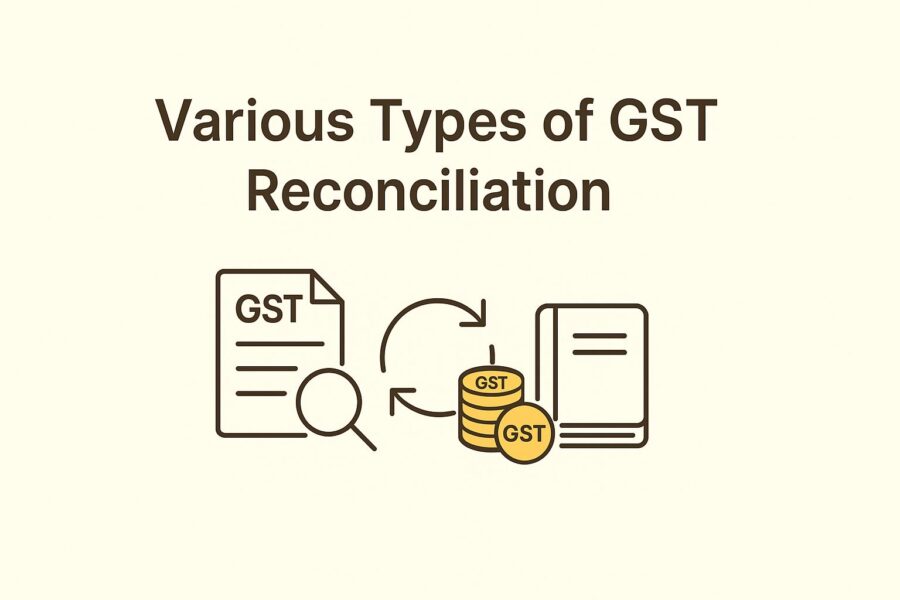
Accurate reconciliation is a crucial part of GSTR-1 returns filing. It allows a taxpayer to claim accurate ITC, validation of all supplies and many more. However, you should know what things they check during the reconciliation process. Here are some important ones.
- Reconciliation of GSTR-1 Return vs Sales Register
This reconciliation helps to verify the accuracy of sales details. It helps to calculate the exact value of supplies made in a given period of time.
- Reconciliation of GSTR-3B Return vs Sales Register
Reconciliation of GSTR-3B vs sales register helps to verify the authenticity of sales by comparing the sales you show with the auto-populated ones. It also helps to verify a taxpayer's tax details of the same sales made in a given period of time.
- Reconciliation of GSTR-3B Return vs Purchase Register
Since we are comparing the purchase register with the GSTR-3B return filing. The reconciliation of GSTR-3B and purchase filings helps to compare and verify the correctness of inward. This implies that inward supplies and Input Tax Credit are the same at a given period of time.
- Reconciliation of GSTR-2A or GSTR-2B Return vs Purchase Register
This reconciliation of GSTR-2A and purchase return helps to verify the details of the value of inward supply by comparing the value given by a supplier and what there is in the auto-populated filing.
- GST Reconciliation of GSTR 3B return vs GSTR 2A or GSTR 2B
This is a reconciliation that taxpayers do by comparing GSTR 3B and GSTR-2B return filings. This kind of reconciliation is important to verify the correctness of your Input Tax Credit in a given period of time. It is done by comparing the taxpayer’s filings with auto-populated filings.
- GST Reconciliation of GSTR-1 Return vs GSTR-3B Return
This kind of reconciliation helps to make sure of the authenticity of sales details. It helps to reconcile a taxpayer’s filing and compare it with the auto-populated filing to get the right amount of outward supplies in a given period of time.
GST Reconciliation: GSTR-1 vs Sales Register
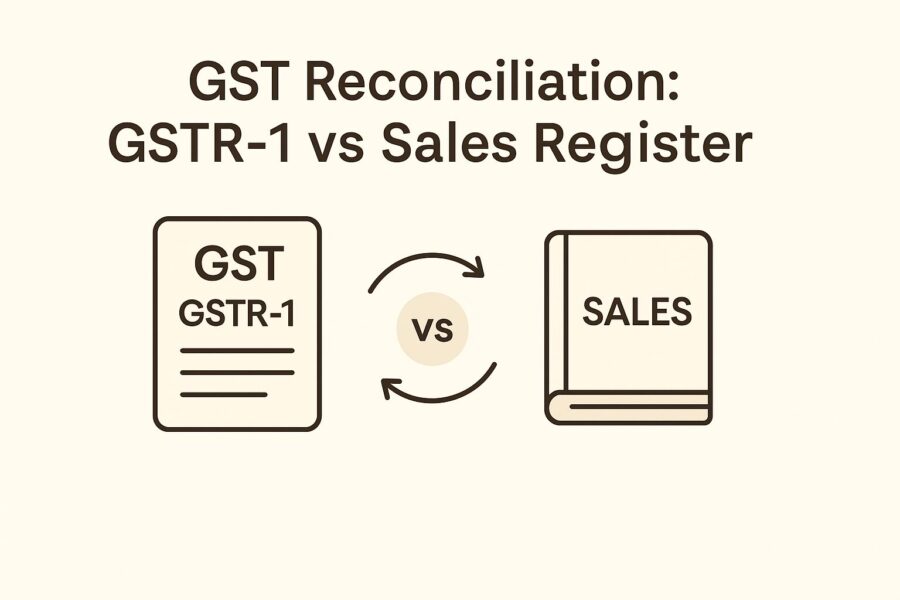
GSTR-1 return filing and sales register both consist of details of outward supplies that a GST-registered person makes during a particular period of time. A comparison of both these details helps a registered person to conclude a correct sales value over a time period.
Regular reconciliation of GSTR-1 and sales register also helps a registered person to finalise their sales figure at the end of a financial year. There are basically two methods of GSTR-1 reconciliation, a manual method and an automatic method.
Regardless of the method used for GSTR-1 reconciliation, it is essential for every GSTIN holder to perform this task each month throughout the financial year.
The manual method is time-consuming and hence, only possible to reconcile if there is a limited number of transactions.
Important Reconciliations for a Proper GSTR-1 e-Filing
You can be non-compliant with GST obligations and might have to face problems even if you file your GSTR on time. This usually occurs due to the lack of proper reconciliation, leading to discrepancies. Knowing how to reconcile your GSTR-1 in the right way is important. Here are a few points to keep in mind while reconciling your GSTR-1 return filing.
- If you want to find out unrecorded transactions or search for discrepancies occurring on either side of the records, you can perform a reconciliation of the general ledger and the sales register.
- If you think one or more transactions are missing in your sales register, you can do a reconciliation of the sales register and GST E-way bill reconciliation.
- You can reconcile your information to the IRP GST E-invoice after you download a draft of GSTR-1 data from the GST Network.
- Get a draft of GSTR-1 from the GST portal and compare it with B2C invoices and non-e-invoices from the sales register to search for discrepancies.
How to Reconcile GSTR-1?

The reconciliation of GSTR-1 is important for a taxpayer as well as for the government to keep records and stay compliant with GST records and tax payments. Here is a step-by-step process on how to reconcile GSTR-1 and the sales register in a manual method:
- Download Your Return File
Download the GSTR-1 return file of that particular financial year and period of time which you want to reconcile. It is the one that you have already filed previously.
- Get Your Sales Register
Get your sales register that has entries of all your transactions of supplies. This is the thing you are going to reconcile your GSTR-1 return filing with.
- Verify The Reporting Period
Make sure that you are scrutinising the same period of time in your GSTR-1 return file and your sales register. Verify the dates of individual transactions also.
- Compare Details in GSTR-1 and Your Sales Register
Review each item in your GStr-1 return filing with the details you have in your sales register. Compare every sales item and supply made, along with your taxable value and tax amount, with your sales register.
- Compare Month Wise
You must initiate GSTR-1 filing every month before the due date. To ensure accuracy, make sure the sales and supply values in your GSTR-1 match those in your sales register. Check the supply value monthly and continue reconciling until all months are aligned.
- Check Possible Ways To Amend The Non-Matching Months
Sometimes, you will not find a way to match the values in your GSTR-1 filing and your sales register. In such cases, you should consider checking some possible ways to amend the errors that you may have committed in the past.
What If Any Sales Invoice Gets Missed in GSTR-1?
The manual process of GSTR-1 reconciliation with your sales register can be overwhelming, time-consuming and prone to errors. Even the act of filing GSTR-1 itself can be complex. In such situations, it is not uncommon to overlook one or two invoices. Here's what happens when that occurs:
- No Record of Transaction
Any details that you leave behind in your GSTR_1 return filing will automatically miss out on your auto-populated GSTR-2A and 2B.
This means there will be no record of those invoices and the person who purchased those items will not be able to avail their ITC on the same. Reconciliation helps to properly reflect your entries for the benefit of the purchaser.
- Discrepancies in GSTR 1 and Sales Register
Any small difference in the values of GSTR-1 and sales register increases the chances of mistakes carrying forward while you are filing your GSTR-3B. This may cause you to make a payment of self-assessed taxes.
Reconciling or comparing GSTR-1 with the sales register can help mitigate the risk of mistakes and avoid any differences between the GSTR-1 return and the GSTR-3B return filing.
- Clerical Error
Simple clerical errors like calculation mistakes or filing under the wrong header are common mistakes but can have a huge impact when you are filing without reconciliation.
- No Record of Inter-State Supplies
Many suppliers make interstate supplies to unregistered people for business purposes. A common error that happens is that they do declare them in their GSTR-1 but forget to register them in GSTR-3B. This can cause discrepancies and mismatches.
Conclusion
Simply filing GSTR-1 within the due date is not enough, you must ensure the information you are submitting is both accurate and complete. Any incorrect or incomplete entries are likely to be flagged during the reconciliation process. Thus, knowing how to reconcile GSTR-1 will help you comply with GST laws.
Failing to comply can result in penalties and if those penalties go unpaid, your GST registration could be revoked. Fortunately, there are many tools and service providers available to assist with filing and reconciling your GST returns.
💡If you want to streamline your payment and make GST payments via credit card, consider using the PICE App. Explore the PICE App today and take your business to new heights.
 By
By 










